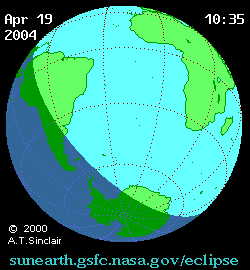Solar eclipse of April 19, 2004
| Solar eclipse of April 19, 2004 | |
|---|---|
| Type of eclipse | |
| Nature | Partial |
| Gamma | −1.1335 |
| Magnitude | 0.7367 |
| Maximum eclipse | |
| Coordinates | 61°36′S 44°18′E / 61.6°S 44.3°E |
| Times (UTC) | |
| Greatest eclipse | 13:35:05 |
| References | |
| Saros | 119 (65 of 71) |
| Catalog # (SE5000) | 9517 |
A partial solar eclipse took place on 19 April 2004.[1][2] A solar eclipse occurs when the Moon passes between Earth and the Sun, thereby totally or partly obscuring the image of the Sun for a viewer on Earth. A partial solar eclipse occurs in the polar regions of the Earth when the center of the Moon's shadow misses the Earth. It was largely visible over the south Atlantic Ocean and north shores of Antarctica, most prominently the Antarctic Peninsula.
The eclipse could also be seen in southern Africa at sunset. Considering the magnitude and the solar altitude, South Africa was the best place to observe this eclipse. In Cape Town, the Sun was about 40% obscured, while in Pretoria the Sun was 29% obscured. Further north, the eclipse remained visible up to Angola, southern DR Congo and Tanzania.
Images[edit]
Related eclipses[edit]
Eclipse season[edit]
This is the first eclipse this season.
Second eclipse this season: 4 May 2004 Total Lunar Eclipse
Eclipses of 2004[edit]
- A partial solar eclipse on April 19.
- A total lunar eclipse on May 4.
- A partial solar eclipse on October 14.
- A total lunar eclipse on October 28.
Solar eclipses 2004–2007[edit]
This eclipse is a member of a semester series. An eclipse in a semester series of solar eclipses repeats approximately every 177 days and 4 hours (a semester) at alternating nodes of the Moon's orbit.[3]
| Ascending node | Descending node | |||||
|---|---|---|---|---|---|---|
| Saros | Map | Gamma | Saros | Map | Gamma | |
| 119 | 2004 April 19 Partial (south) |
−1.13345 | 124 | 2004 October 14 Partial (north) |
1.03481 | |
129 Partial from Naiguatá |
2005 April 08 Hybrid |
−0.34733 | 134 Annular from Madrid, Spain |
2005 October 03 Annular |
0.33058 | |
139 Total from Side, Turkey |
2006 March 29 Total |
0.38433 | 144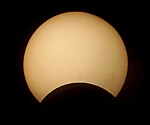 Partial from São Paulo, Brazil |
2006 September 22 Annular |
−0.40624 | |
149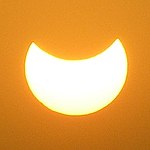 From Jaipur, India |
2007 March 19 Partial (north) |
1.07277 | 154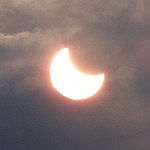 From Córdoba, Argentina |
2007 September 11 Partial (south) |
−1.12552 | |
Saros 119[edit]
It is a part of Saros cycle 119, repeating every 18 years, 11 days, containing 71 events. The series started with partial solar eclipse on May 15, 850 AD. It contains total eclipses on August 9, 994 AD and August 20, 1012, with a hybrid eclipse on August 31, 1030. It has annular eclipses from September 10, 1048, through March 18, 1950. The series ends at member 71 as a partial eclipse on June 24, 2112. The longest duration of totality was only 32 seconds on August 20, 1012. The longest duration of annularity was 7 minutes, 37 seconds on September 1, 1625. The longest duration of hybridity was only 18 seconds on August 31, 1030.
| Series members 54–70 occur between 1801 and 2100: | ||
|---|---|---|
| 54 | 55 | 56 |
 December 21, 1805 |
 January 1, 1824 |
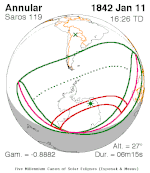 January 11, 1842 |
| 57 | 58 | 59 |
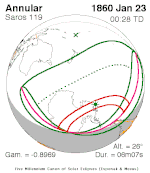 January 23, 1860 |
 February 2, 1878 |
February 13, 1896 |
| 60 | 61 | 62 |
 February 25, 1914 |
 March 7, 1932 |
 March 18, 1950 |
| 63 | 64 | 65 |
 March 28, 1968 |
 April 9, 1986 |
 April 19, 2004 |
| 66 | 67 | 68 |
 April 30, 2022 |
 May 11, 2040 |
 May 22, 2058 |
| 69 | 70 | |
 June 1, 2076 |
 June 13, 2094 | |
Metonic series[edit]
The metonic series repeats eclipses every 19 years (6939.69 days), lasting about 5 cycles. Eclipses occur in nearly the same calendar date. In addition, the octon subseries repeats 1/5 of that or every 3.8 years (1387.94 days). All eclipses in this table occur at the Moon's ascending node.
| 21 eclipse events, progressing from south to north between July 1, 2000 and July 1, 2076 | ||||
|---|---|---|---|---|
| July 1–2 | April 19–20 | February 5–7 | November 24–25 | September 12–13 |
| 117 | 119 | 121 | 123 | 125 |
 July 1, 2000 |
 April 19, 2004 |
 February 7, 2008 |
 November 25, 2011 |
 September 13, 2015 |
| 127 | 129 | 131 | 133 | 135 |
 July 2, 2019 |
 April 20, 2023 |
 February 6, 2027 |
 November 25, 2030 |
 September 12, 2034 |
| 137 | 139 | 141 | 143 | 145 |
 July 2, 2038 |
 April 20, 2042 |
 February 5, 2046 |
 November 25, 2049 |
 September 12, 2053 |
| 147 | 149 | 151 | 153 | 155 |
 July 1, 2057 |
 April 20, 2061 |
 February 5, 2065 |
 November 24, 2068 |
 September 12, 2072 |
| 157 | 159 | 161 | 163 | 165 |
 July 1, 2076 |
||||
References[edit]
- ^ "Sky". The Desert Sun. 2004-04-19. p. 32. Retrieved 2023-10-25 – via Newspapers.com.
- ^ "The stars". Poughkeepsie Journal. 2004-04-19. p. 2B. Retrieved 2023-10-25 – via Newspapers.com.
- ^ van Gent, R.H. "Solar- and Lunar-Eclipse Predictions from Antiquity to the Present". A Catalogue of Eclipse Cycles. Utrecht University. Retrieved 6 October 2018.


